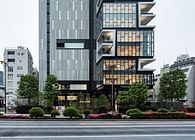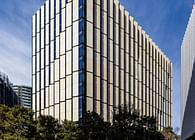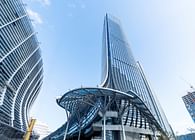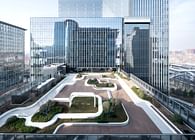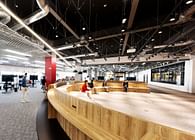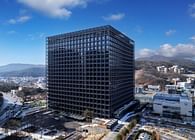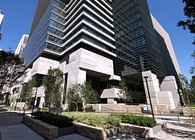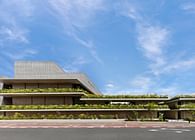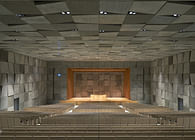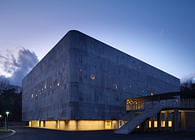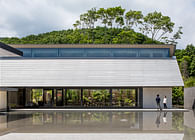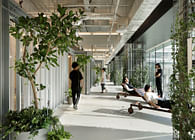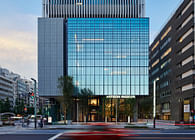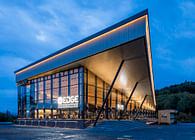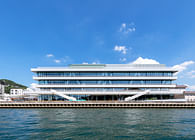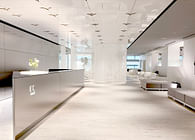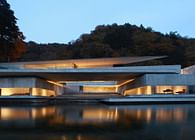
The reconstruction plan for the Yanmar Tokyo office on the east side of Tokyo Station, one of Japan’s most iconic train terminals. Yaesu, the business district to the east of the station, was a center for logistics by canal in the Edo era. Today, it has become a popular district with some of the best development potential in the country, with several major redevelopment projects taking root. The building bridges Tokyo Station and the Yaesu area and acts as a branding hub for Yanmar, a company that develops technology for “food production” and “energy conversion” worldwide. Its exterior and interior environment is designed to make it a suitable face for the company in this station-front location.
A ship-like building “sets sail” toward the world
The street-facing façade toward Tokyo Station is clad in pipe louvers. On the ground level and below, the façade’s form mimics the bow of a ship, and above, a sail. We aimed for a strong form that prioritizes purity, symbolism, and autonomy, with an awareness of the axis between the site and the adjacent intersection. The design was made possible by the corner condition of the site, and speaks to both the situation of the building and the client company. Inspired by Yaseu’s history as the location of the former canal beneath the Edo Castle, as well as Yanmar’s work in the maritime field, this iconic ship-like design makes a statement toward the world.
Public space as a branding hub
On the south exterior wall is a large-scale pipe louver greening system covering approximately 800 m2. The greenery can be perceived from anywhere in the common areas of the office floor, such as the elevator hall, restrooms, and refreshment corners. The green wall can also be seen from the neighboring building to the south, and provides a natural environment within the city.
In the three-story atrium on the lower level, louvered greenery is grown using hydroponics. Circadian LED lighting serves both as a plant growing device and as a spatial effect for the entire atrium, and changes color temperature from moment to moment throughout the day. This is a biophilic public space, rare in the vicinity of Tokyo Station, where anyone can come and go freely, and where those on the go might want to stop and linger. The green atrium space, together with the large-scale greening of the exterior walls, is an expression of Yanmar’s work with the earth. Natural materials in the finishes, such as wood flooring and louvers on the ceiling, also represent this element.
The building also features spaces born from Yanmar’s recognition of the great importance of rice farming in Japan. On the first floor is a gallery, and on the second floor is a restaurant that highlights rice and agriculture. The atrium creates a continuous bustling atmosphere from the basement to the second floor, and the space itself serves as a piece of content that communicates the Yanmar brand.
The entrance and elevator hall on the B1 floor offer a view of this atrium space, where the various activities and light effects over time can be felt by employees as they enter and leave the office. This public space is a major feature in the approach of this building, and sets the standard for office buildings in front of Tokyo Station.
A living showroom for an environmentally conscious company
Energy-saving and high-efficiency Yanmar products are used in the equipment of this building, making it a living showroom for customers. A variety of Yanmar products are incorporated—including a cogeneration system using gas engine generators and a radiant heating and cooling system using high-efficiency gas heat pump air conditioners—to achieve high BCP and environmental performance. In addition, the building incorporates the latest technologies for disaster prevention, environment, and living comfort, such as a mid-story seismic isolation structure for the office floors, a public plaza on the B1 floor to provide a temporary evacuation site for people who cannot return home, wall solar panels, wind power generation, and a natural ventilation system that uses radiation in combination with a perforated panel ceiling.
Project name: YANMAR TOKYO
Usage: Tenant building/Commercial
Location (Prefecture, city): Chuo City, Tokyo
Site area (m2): 1,483.79
Total floor area (m2): 21,775.59
Number of floors: -3+14P2
Eave height, highest point (m): 63.850 m/69.950 m
Main structure: Steel/Steel-reinforced concrete (Seismic isolation structure (IIS))
Completion date: 2022/08
Credit
Owner (Japanese): セイレイ興産株式会社
Owner (English): Seirei Kosan CO.,LTD
Lead architect: Nikken Sekkei
Main scope: Nikken Sekkei (Schematic design, Detailed design, Supervision)
JV, joint design, supervision, consultancy, etc.: SAMURAI Kashiwa Sato (Atrium design supervision, artwork)
Construction company: Takenaka Corporation
Photo credit: Kawasumi・Kobayashi Kenji Photograph Office
Status: Built
Location: Tokyo, JP
Firm Role: Lead Architect (Schematic design, Detailed design, Supervision)
Additional Credits: JV, joint design, supervision, consultancy, etc.: SAMURAI Kashiwa Sato (Atrium design supervision, artwork)
Construction company: Takenaka Corporation
Photo credit: Kawasumi・Kobayashi Kenji Photograph Office





